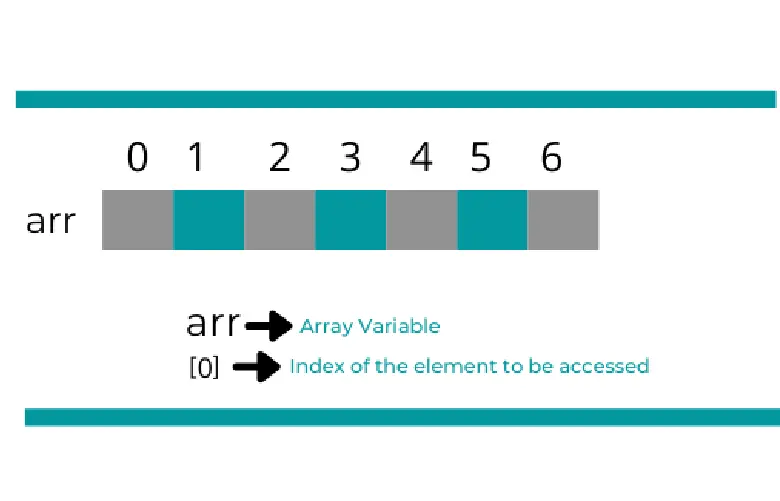Arrays are an important part of any programming language, and C, C++ is no exception. Arrays in C, C++ provide a way to store multiple values in one data structure, allowing for efficient access and manipulation of the data stored within them. Understanding how arrays can be used in C and C++ is essential for writing efficient code.
This article will cover everything you should know about arrays in C and C++, including their from define array in C to uses, syntax, examples, and more. With this knowledge, you’ll be better equipped to use arrays when coding in either language!
Let’s get started.
What are C++ Arrays?
C++ Arrays are a collection of objects stored in contiguous memory locations. They are an efficient data structure for storing and manipulating large amounts of data. In C++, arrays can store any object, including numbers, strings, or complex structures. An array is defined by its length (the number of elements it contains) and its element’s type (what type of values does it hold).
Arrays can also be used in C programming. It works the same way as in C++ but requires additional syntax rules when declaring them and accessing their elements. Moreover, DevOps Engineering also uses C and C++ arrays as they are an efficient data structure for storing, manipulating, and transferring large amounts of data.


POSTGRADUATE PROGRAM IN
Multi Cloud Architecture & DevOps
Master cloud architecture, DevOps practices, and automation to build scalable, resilient systems.
Uses of C++ Arrays
- C++ Arrays can store multiple values in a single variable instead of declaring separate variables for each value.
- They allow programmers to easily access and manipulate related data without writing extra code.
- Arrays can also be used in sorting algorithms such as selection sort and bubble sort, where the array is sorted by comparing adjacent elements and swapping them if they are not in order.
- Arrays can also be used for searching algorithms, such as linear search and binary search, which quickly locate specific items in an array by checking each element until the desired item is found.
Array Declaration in C/C++
In C/C++ arrays are declared using the following syntax: `data_type array_name[] = {list of values}`
For example, if we wanted to declare an array of integers in C, it would look like this:
```int myarray[] = {1 , 2, 3, 4}; ```The array name is “myarray”, and its data type is int. The number of elements in the following list will determine the size of the array. In this example, there are four elements, meaning that myarray is an array with four elements. Check out this blog Top 10 Major Characteristics of Cloud Computing by Hero Vired.
Access Elements in C++ Array
In C++, arrays are a collection of similar items stored together in memory. To access or manipulate elements within an array, the programmer must use specific commands to refer to each element by its index number (starting at 0). You need to understand the syntax used to access elements in an array.
To access elements in a C++ array, we use either brackets [] or pointers depending on what type of data is stored inside the array. If the array is storing integers and characters, we use brackets: `myArrayName[].`

82.9%
of professionals don't believe their degree can help them get ahead at work.
C++ Array Initialization
When it comes to programming, arrays are a data type used to store collections of information. In C++, arrays allow you to assign multiple values to a single variable. This makes them incredibly useful for organizing and manipulating data with ease.

One important aspect of working with arrays in C++ is array initialization. Initializing an array properly will ensure that your code runs smoothly and efficiently. Here we’ll take a look at what array initialization is, how it works in both C and C++ languages, and how it affects your coding experience.
Types of Array in C, C++
| C++ Single-Dimensional Array | A single-dimensional array is the most basic type of array which consists of a singular row and multiple columns. This is also known as a one-dimensional array in C++. It can store multiple values, but all the elements will have the same data type. For example, an integer array of size 10 can only store 10 integers. |
| C++ Multidimensional Array | A multidimensional array allows you to store multiple values in one variable, also known as a rectangular array or matrix. Multidimensional arrays can have any dimensions, but they are usually two-dimensional (2D) or three-dimensional (3D). In C++, multidimensional arrays are declared using the syntax:
For example, if you want to declare an integer 2D array with 3 rows and 5 columns you would use this syntax: |
Advantages of Array in C/C++
When you’re clear about what is a Array in C/C++ and various types of arrays, let’s look at the advantages of arrays.
Easy to use
Arrays are one of the most versatile data structures in the C/C++ programming language, allowing developers to store multiple values in a single variable. This simplifies the code and ensures that data is stored logically and efficiently.Random access
One of the primary advantages to using arrays in C/C++ is their ability to be accessed randomly. This means that elements within an array can be accessed directly and immediately, regardless of where they are located in the array.Memory efficiency
Arrays in C/C++ are a great tool when memory efficiency is of the utmost importance. This is because arrays take up a contiguous block of memory, meaning they occupy less memory than an individual element would.Flexibility
One of the advantages of arrays in C/C++ is it offers flexibility when you need to manipulate data. Arrays are linear collections of elements and can store any data. You can also easily use arrays for sorting, searching, and manipulating data. This makes them ideal for many tasks like dynamically allocating memory, creating dynamic structures with multiple dimensions, etc.Performance
Arrays in C/C++ offer the best performance when compared to other data structures. This is because accessing elements stored in an array is simple, allowing it to be done quickly and efficiently with minimal overhead. Since arrays are linear data structures, searching for an element is significantly easier than searching through a tree or linked list structure.Disadvantages of Array in C/C++
Fixed size
Arrays have a fixed size in both C and C++. This means once an array is declared, it cannot be increased or decreased in size as needed. This can be troublesome if the amount of data changes frequently, as the programmer will need to create a new array and copy over all elements from the old one.Lack of flexibility
Array in C/C++ is a static data structure, meaning the size of an array needs to be defined at compile time and cannot be changed afterwards. This limitation makes arrays inflexible for dynamic memory allocation where the amount of required memory is unknown or changes during runtime.Overhead
Arrays in C/C++ can cause extra overhead regarding memory allocation, as they take up a fixed amount of space regardless of how much is needed. This means that if the array needs to be increased or decreased during run time, there will need to be separate functions dedicated to allocating and deallocating memory – otherwise, this would require manual processes on behalf of the programmer.Array Declaration in C/C++
Arrays are a fundamental data structure in programming, and they can be used to store columns of data or collections of objects. In C/C++ arrays must be declared before use, otherwise, the compiler will throw an error. To declare an array in C/C++, you start by specifying the type of element that will be stored in the array (e.g., int for integers), followed by the name of the array, and then brackets containing the size (number) of elements that your array can hold.
For example, the following code declares an array called myArray of 10 elements (ints):
```
int myArray[] = {1,2,3,4,5,6,7,8,9,10};
```
After an array declaration in c, you can access individual elements using the index of the element within the array of structure in c.
Scope of Arrays in C/C++
Arrays are the most commonly used data structures in C/C++ programming languages. Arrays allow programmers to store and manipulate large amounts of data efficiently. In C and C++, arrays are composed of a collection of elements stored consecutively in memory. Each element can be accessed individually for manipulation or retrieval by referencing the array’s index.
The size of an array is established when it is declared and cannot be changed afterwards, making arrays an ideal option for managing static data sets such as lists or tables. Also, arrays can contain any object or primitive value so long as all elements within the array share the same type. Read about What is a Cloud Service Provider!
Example of C/C++ Array
An array is a collection of elements of the same type, stored in contiguous memory locations. Each element can be accessed by an index or subscript value corresponding to its location within the array. Array in c programming is defined with a type, followed by square brackets and the variable name. For instance:
`int myArray[] = {1,2,3};`
This statement creates an array called `myArray,` which holds three integer values (1, 2, and 3) in consecutive memory cells. The individual elements are accessed using their corresponding position within the array; for example, `myArray{0]` refers to the first element in the array (1), `myArray{1]` refers to the second element (2), and `myArray{2}` refers to the third element (3).
It is also possible to define an array with a specific size by including the number of elements in square brackets after the name.
Important things to remember while using arrays in C++
- Arrays in C++ are linear data structures that store a fixed number of elements of the same type.
- The size & type of an array cannot be changed after declaration. If the size needs to be changed, the array must be completely recreated.
- Arrays can also be multidimensional in C++, which allows them to store multiple sets of data in one single array object.
- When declaring an array object in C++, it is important to remember that the name of an array is a pointer to the first element of the array of structure in c.
How to insert and print array elements?
How to declare an array in C, and C++?
How to Initialize Arrays in C, C++?
How can one access an element in an array?
What is a multi-dimensional array in C, C+_+?
Updated on June 20, 2024
